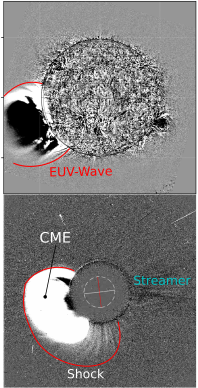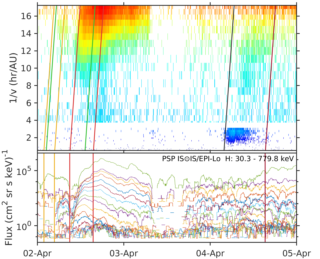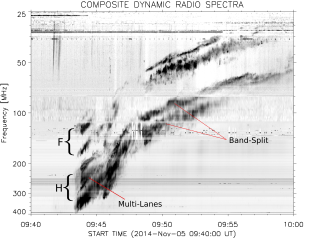Research
My research aims to understand the physical mechanisms behind impulsive energy releases in the solar corona. This includes their progenitors (Coronal Mass Ejections (CMEs) and flares), their effect on the global solar atmosphere and their ability in accelerating charged particles that can fill the entire heliosphere.
Shock Waves

Shock waves lie at the heart of a variety of phenomena in space-plasma physics. Studying their physical properties and the processes leading to powerful particle acceleration is essential and represents a considerable observational and theoretical challenge in astrophysics. In the solar corona, shock waves can occur due to the flare process or by coronal mass ejections (CMEs) when they propagate into a plasma flow with either super-Alfvénic or super-magnetosonic speed. Some of them can continue travelling as shocks in the interplanetary space and they are detected in-situ at 1 AU.
The existence of coronal shock waves has long been established based on radio observations of metric type II radio bursts. This transient form of radio emission is generated when magnetohydrodynamic (MHD) shocks in the solar atmosphere accelerate electron beams that excite Langmuir waves owing to beam-plasma instabilities. The Langmuir waves can be converted by nonlinear wave-plasma processes to radio waves, observable as electromagnetic emission close to the local plasma frequency (fundamental) and/or its harmonic frequencies, resulting in type II radio emission.
MHD coronal waves have also been observed as propagating disturbances in the chromosphere at the optical observation of Hα wings. These phenomena are called Moreton–Ramsey waves and are initially interpreted as the chromospheric response to the fast magnetosonic waves travelling in the solar corona. Propagated coronal waves are also observed at extreme ultraviolet (EUV) and are called EUV waves. Some of the EUV waves are fast enough to steepen into shock waves propagating in the low corona. White light (WL) coronagraphic observations also show the presence of faint fronts ahead of the CMEs where small increases in the WL intensity are detected. These regions are interpreted as the compressed coronal plasma ahead of the CME called ``shock sheath regions’’ that are produced by the shock waves driven by the super-alfvénic expansion of the CME. The development of coronal shock waves during CMEs is likely a key component to this particle acceleration.
Solar Energetic Particles

Solar energetic particles (SEP) events, especially those with large intensity increases, widespread distribution, and high energy particles producing ground level enhancement (GLE) events, are the most important elements of space weather and pose a significant hazard to the inner heliosphere. These SEPs can fill up the inner heliosphere in minutes and can sometimes penetrate deep inside planetary atmospheres such as the Earth, where they are measured on the ground. As such they represent a serious threat to human activity in the near-Earth environment and for manned space missions and exploration. SEP research is therefore critical in the rapidly expanding field of space weather research.
Our knowledge about these SEP events has significantly increased over the past several decades. A number of important physical processes have been identified to contribute to the energetic particle acceleration, propagation, and distribution to the heliosphere. However, some details of the physical processes are still not well understood and more importantly, it has been difficult to distinguish different mechanisms and evaluate their relative role in the acceleration and transport of SEPs from measurements taken near 1 AU.
SEPs are accelerated during solar flares and coronal mass ejections (CMEs) and are observed in situ in the Heliosphere. Multi-messenger observations of the solar eruptions reveal multiple locations where the SEPs could be produced by the first-order or/and second-order Fermi type acceleration. The development of coronal shock waves during CMEs is likely a key component to this particle acceleration. In addition, the source of SEPs has also been related to magnetic reconnection occurring deep inside solar flares that constitute another important by-product of CMEs.
Solar Radio and γ-Ray Emission

Solar radio bursts associated with shock waves (i.e. so called type II radio bursts) are the oldest known signatures of shocks. They are mostly used to map the propagation of the shocks through the corona and the interplanetary (IP) space. Shock-associated radio emission is produced when non-thermal electrons undergo non-linear wave-particle interactions and emit electromagnetic radiation close to the fundamental and/or the harmonic local plasma frequency. Type II bursts are observed in the dynamic spectra as slowly drifting and often intermittent narrow band radio emission. The processes leading to the generation of the shock associated radio emission are very complex because they depend on both macroscopic parameters such as shock wave properties and kinetic scales such as the distribution of the electrons and their properties.
